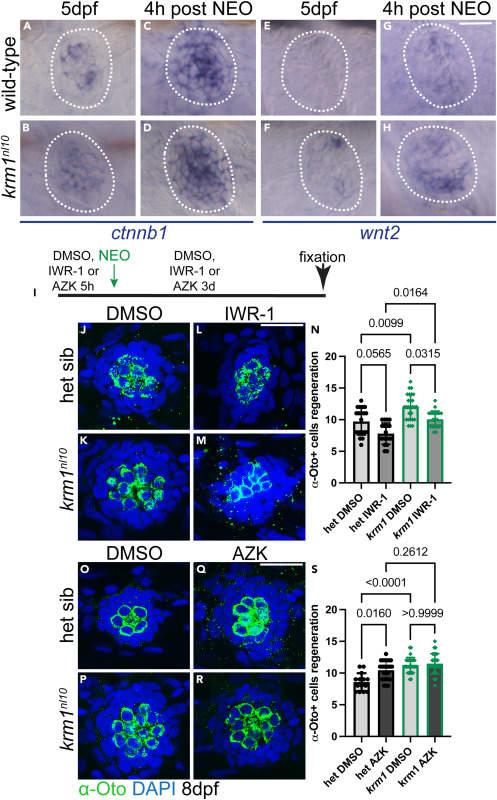Fig. 3 Wnt signaling is active during regeneration in krm1nl10 neuromasts (A–D) Representative images of RNA in situ hybridization at 5dpf of ctnnb1 expression in wild-type and krm1nl10 mutant NMs without exposure to NEO and 4 h post NEO exposure. (E–H) wnt2 expression in wild-type and krm1nl10 mutant NMs without exposure to NEO and 4 h post NEO exposure. Scale bar = 20 μm. (I) Timeline of DMSO or inhibitor exposure, NEO-induced hair cell ablation, and regeneration between 5dpf and 8dpf. (J–M) Confocal projects of 8dpf NMs following regeneration, hair cells are labeled with α-Otoferlin antibody (green) and nuclei are labeled with DAPI (blue) in heterozygous sibling or krm1nl10 NMs with exposure to DMSO or IWR-1. (N) Quantification of α-Otoferlin-positive cells. DMSO-exposed heterozygous sibling n = 20 NM (8 fish) and IWR-1-exposed heterozygous sibling n = 19 NM (9 fish), and DMSO-exposed) and IWR-1-exposed krm1nl10 n = 20 NM (9 fish). (O–R) Confocal projects of 8dpf NMs following regeneration, hair cells are labeled with α-Otoferlin antibody (green) and nuclei are labeled with DAPI (blue) in heterozygous sibling or krm1nl10 NMs with exposure to DMSO or AZK. (S) Quantification of α-Otoferlin-positive cells. DMSO-exposed heterozygous sibling n = 14 NM (8 fish) and DMSO-exposed krm1nl10 n = 29 NM (9 fish), and AZK-exposed heterozygous sibling n = 26 NM (11 fish) and AZK-exposed krm1nl10 n = 28 NM (9 fish). All data presented as mean ± SD, Kruskal-Wallis test, Dunn’s multiple comparisons test. Scale bar = 20 μm. See also Figure S1.
Image
Figure Caption
Acknowledgments
This image is the copyrighted work of the attributed author or publisher, and
ZFIN has permission only to display this image to its users.
Additional permissions should be obtained from the applicable author or publisher of the image.
Full text @ iScience

